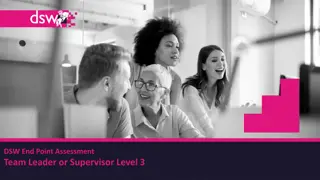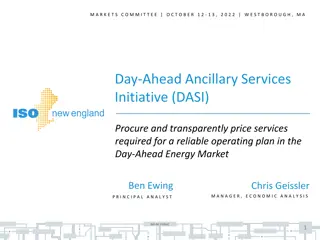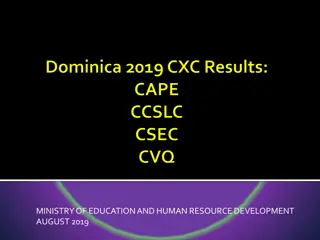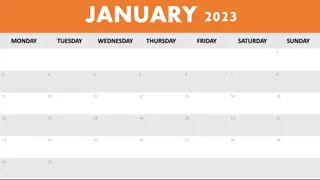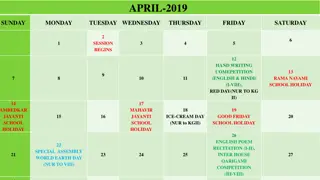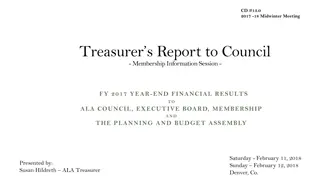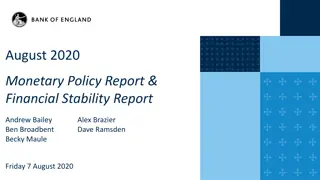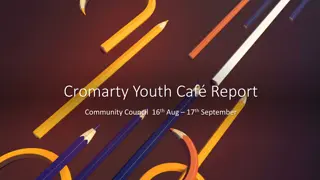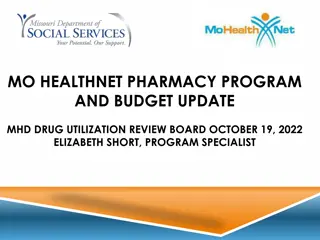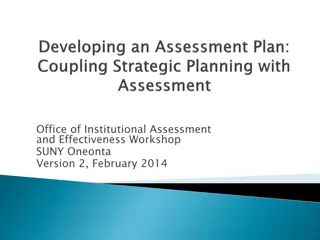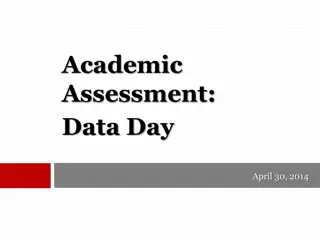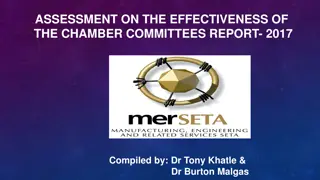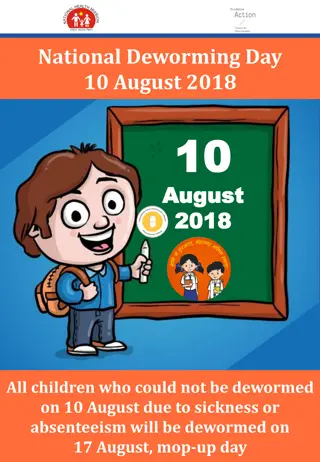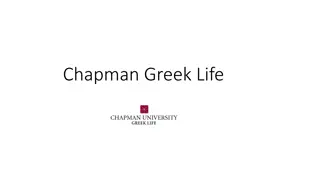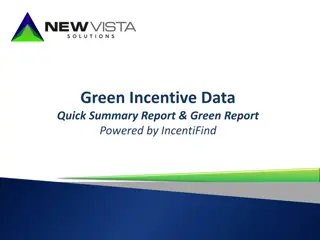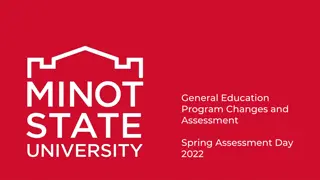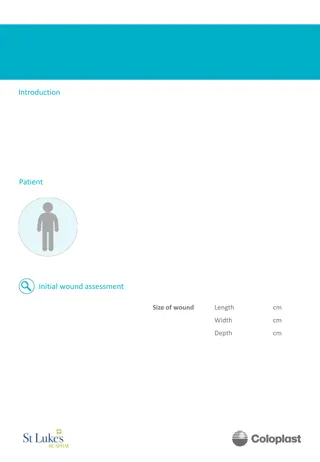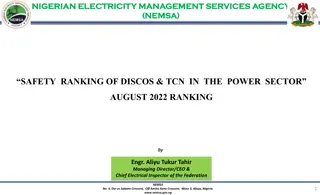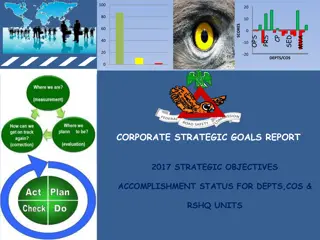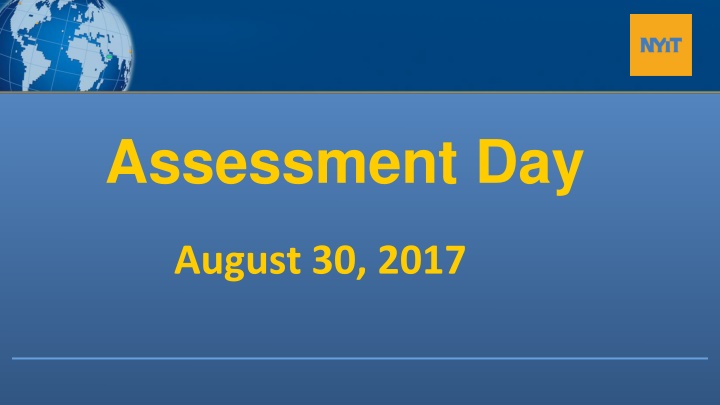
Assessment Day August 30, 2017 Summary Report
Agenda for Assessment Day on August 30, 2017 included discussions on the annual program assessment report, oral communication results, information literacy initiative, Middle States expectations, and future program effectiveness assessment. The report detailed updated program level learning outcomes, assessment matrices, alignment with institutional goals, actions for improving student learning, and assessment results. Professional accreditation self-study reports for various programs and accreditation bodies were also highlighted. NYIT learning goals were outlined to emphasize skills, values, communication, critical analysis, technological competency, and global engagement.
Download Presentation

Please find below an Image/Link to download the presentation.
The content on the website is provided AS IS for your information and personal use only. It may not be sold, licensed, or shared on other websites without obtaining consent from the author. If you encounter any issues during the download, it is possible that the publisher has removed the file from their server.
You are allowed to download the files provided on this website for personal or commercial use, subject to the condition that they are used lawfully. All files are the property of their respective owners.
The content on the website is provided AS IS for your information and personal use only. It may not be sold, licensed, or shared on other websites without obtaining consent from the author.
E N D
Presentation Transcript
Assessment Day August 30, 2017
Agenda: Agenda: Report AY 16-17 annual program assessment report Oral communication results and Information literacy initiative Middle States expectations and future program effectiveness assessment Strategic Plan and Self-Study
AY 16 AY 16- -17 Assessment Report 17 Assessment Report 1. 2. Updated program level learning outcomes. Updated assessment matrix, which connect program learning outcomes to course learning outcomes. Aligned program level learning outcome to institutional educational goals. Summarized past three years assessment informed actions in improving students learning. Assessed at least two program level learning outcomes. Report oral communication assessment results. 3. 4. 5. 6.
AY 16 AY 16- -17 Assessment Report 17 Assessment Report 64 degree programs at all levels (Bachelor level and Master level) from both New York and global campus submitted reports, 57 completed, 7 partially complete. SOM reports (9) is due 9/15/2017 NYITCOM (6) due 10/31/2017
AY 16 AY 16- -17 Professional 17 Professional Accreditation Self Accreditation Self- -study study School of Engineering and Computer Sciences 4 B.S., Programs-CS, ECE, ECET, ME-Program Self-Study to ABET NYITCOM- 3 Reports to COCA School of Management-AACSB BSBA & MBA Report to AACSB School of Architecture and Design B.Arch. NAAB self-study report for continuing accreditation. BFA interior design, CIDA report. School of Health Professions MS Physician Assistant Report to ARC-PA D.P.T Report to CAPTE School of Interdisciplinary Studies and Education Advanced School leadership and Technology-ELCC MS Instructional Technology-ISTE MS Childhood Education-ACEI Early Childhood Education: NAEYC
NYIT Learning Goals NYIT Learning Goals 1. Gain a coherent understanding of the knowledge, skills, and values of their discipline 2. Achieve proficiency in oral and written communication, scientific and quantitative reasoning, critical analysis, technological competency, and information literacy 3. Integrate academic and co-curricular learning to explore concepts and questions that bridge disciplines, professions, and cultures 4. Formulate evidence-based and ethical courses of action or conclusions to address challenges and problems 5. Engage with, respond to, and reflect on political, social, environmental and economic challenges at local, national, and global levels 6. Develop self-efficacy, professionalism, creativity, and an innovative spirit
used AACU rubric AACU rubric) ) Programs ( Programs (used Graduate-9 MBA program MS, Architecture, Urban and Regional Design MS, Clinical Nutrition MSIT, Instructional Technology MS, School Counseling MFA, Computer Graphics (Graphic Design, Animation, and Art & Technology) MS, Energy Management MFA, Computer Graphics School Leadership and Technology Advanced Diploma Undergraduate-11 BS,BA Business Administration BS, Psychology BS, Criminal Justice BS, Behavioral Sciences (Sociology/Social Work) BFA Interior Design English Department Core (FCWR 3xx) BS Health Sciences/Health & Wellness BS, Biology BFA, Computer Graphics BFA, Graphic Design BS, Urban Administration
Oral Communication Oral Communication Assessment Assessment Total of 512 Total of 512: : Undergraduates: Graduates: 320 192
AACU Oral Communication AACU Oral Communication Rubric (scale 1 Rubric (scale 1- -4) 4) Rubric Definition: Oral communication is prepared, purposeful presentation designed to increase knowledge, to foster understanding, or to promote change in the listeners attitudes, values, beliefs, or behaviors. 1. Organization 2. Language 3. Delivery 4. Supporting Material 5. Central Message
Capstone 4 Milestones Benchmark 1 3 2 Organizational pattern (specific introduction and conclusion, sequenced material within the body, and transitions) is clearly and consistently observable and is skillful and makes the content of the presentation cohesive. Organizational pattern (specific introduction and conclusion, sequenced material within the body, and transitions) is clearly and consistently observable within the presentation. Organizational pattern (specific introduction and conclusion, sequenced material within the body, and transitions) is intermittently observable within the presentation. Organizational pattern (specific introduction and conclusion, sequenced material within the body, and transitions) is not observable within the presentation. Organization Language choices are imaginative, memorable, and compelling, and enhance the effectiveness of the presentation. Language in presentation is appropriate to audience. Language choices are thoughtful and generally support the effectiveness of the presentation. Language in presentation is appropriate to audience. Language choices are mundane and commonplace and partially support the effectiveness of the presentation. Language in presentation is appropriate to audience. Language choices are unclear and minimally support the effectiveness of the presentation. Language in presentation is not appropriate to audience. Language Delivery techniques (posture, gesture, eye contact, and vocal expressiveness) make the presentation compelling, and speaker appears polished and confident. Delivery techniques (posture, gesture, eye contact, and vocal expressiveness) make the presentation interesting, and speaker appears comfortable. Delivery techniques (posture, gesture, eye contact, and vocal expressiveness) make the presentation understandable, and speaker appears tentative. Delivery techniques (posture, gesture, eye contact, and vocal expressiveness) detract from the understandability of the presentation, and speaker appears uncomfortable. Delivery A variety of types of supporting materials (explanations, examples, illustrations, statistics, analogies, quotations from relevant authorities) make appropriate reference to information or analysis that significantly supports the presentation or establishes the presenter's credibility/authority on the topic. Supporting materials (explanations, examples, illustrations, statistics, analogies, quotations from relevant authorities) make appropriate reference to information or analysis that generally supports the presentation or establishes the presenter's credibility/authority on the topic. Supporting materials (explanations, examples, illustrations, statistics, analogies, quotations from relevant authorities) make appropriate reference to information or analysis that partially supports the presentation or establishes the presenter's credibility/authority on the topic. Insufficient supporting materials (explanations, examples, illustrations, statistics, analogies, quotations from relevant authorities) make reference to information or analysis that minimally supports the presentation or establishes the presenter's credibility/authority on the topic. Supporting Material
Results for 320 Undergraduate Results for 320 Undergraduate Students Students 3.35 3.4 3.25 3.3 3.24 3.17 3.2 3.1 2.97 3 2.9 2.8 2.7 Organization Language Delivery Supporting material Central message
Undergraduate Area to Improve Undergraduate Area to Improve - - Delivery (2.97/4.0) Delivery (2.97/4.0) 4/4:Delivery techniques (posture, gesture, eye contact, and vocal expressiveness) make the presentation compelling, and speaker appears polished and confident.
Results for Results for 192 Graduate 192 Graduate Students Students 3.28 3.3 3.24 3.25 3.2 3.2 3.17 3.15 3.12 3.1 3.05 3 Organization Language Delivery Supporting material Central message
Graduate Area to Improve Graduate Area to Improve - - Language (3.12/4.0) Language (3.12/4.0) 4/4-Language choices are imaginative, memorable, and compelling, and enhance the effectiveness of the presentation. Language in presentation is appropriate to audience.
Other Communication Other Communication Skill Assessment Report Skill Assessment Report B. Arch Program Report_SPC-A1 -Ability to write and speak effectively and use appropriate representational media both with peers and with the general public. Five courses (AAID 160, ARCH 361, 362, 501, 502) 23 sections were assessed approximately 300 students. 2017 NAAB Team Assessment: This criterion is met with Distinction. ..The thesis research documentation was exemplary.
NYIT Learning Goals NYIT Learning Goals 1. Gain a coherent understanding of the knowledge, skills, and values of their discipline 2. Achieve proficiency in oral and written communication, scientific and quantitative reasoning, critical analysis, technological competency, and information literacy 3. Integrate academic and co-curricular learning to explore concepts and questions that bridge disciplines, professions, and cultures 4. Formulate evidence-based and ethical courses of action or conclusions to address challenges and problems 5. Engage with, respond to, and reflect on political, social, environmental and economic challenges at local, national, and global levels 6. Develop self-efficacy, professionalism, creativity, and an innovative spirit
Information Literacy Information Literacy Assessment Initiative Assessment Initiative The goal The process The workshop evaluation The participants: 4 librarians: Danielle Apfelbaum, David Cirella, Naomi Binnie, Vanessa Viola 14 Faculty: Dina Karafantis, Susan Neville Maureen Cardoza, Melda Yildiz, Aydin Farajidavar, Maherukh Akhtar, Amanda Golden, xsReza Khalaj Amineh, John DiDomenico, Jeffrey Raven,Wenjia Li, Nabi Sertac Artan, Houwei Cao, Paolo Gasti
Middle States Expectations for Middle States Expectations for Program Program- -Level Learning Outcomes Level Learning Outcomes Assessments of Institutional Learning & Achievement Goals Demonstrates and improves institution s learning and achievement goals. Program Learning Outcome Assessments Demonstrates and improves learning outcomes in programs. Ensures that program curriculum adequately addresses all program learning goals. Curriculum Mapping Demonstrates and improves learning outcomes in courses. Course-based Assessments
Expectations Continued Expectations Continued What we are looking for regarding your program level learning outcomes (PLOs) themselves: Review and revise on a regular basis Development of learning outcome assessment
Assessment of Student Learning Assessment of Student Learning Has Come a Long Way Has Come a Long Way Science and Engineering Area The Carl Wieman Science Education Initiative - http://bit.ly/2xxPje5 Social Science Area Social Science Research Council (Measuring College Learning Project) - http://bit.ly/2wSXLr4 In the Health Science Area AAMC Scientific Foundation for Future Physicians: Scientific foundation for future physicians - http://bit.ly/2wSV9d0
Expectations Continued Expectations Continued What we are looking for regarding the methods you use to measure students progress in meeting PLOs, and in your assessment results and analysis of the assessment data you collect regarding your PLOs:
Expectations Continued Expectations Continued What we are looking for regarding how you use your assessment results to improve your program and your achievement of learning outcomes, and the effectiveness of your program improvement plan once it has been implemented:
Expectations Continued Expectations Continued What we are looking for regarding your faculty s involvement in the entire process:
The Future Program Effectiveness The Future Program Effectiveness Assessment Assessment It should be based on your program s mission and goals. It should be continuous effort to improve both learning and students success.
NYIT Strategic Planning and NYIT Strategic Planning and Middle States Middle States Study Study Two very important activities will be going on simultaneously this fall: NYIT will begin a year-long self-study process as required by Middle States as part of our 2019 reaccreditation. NYIT will develop a new strategic plan as called for by our Board of Trustees and President. Both activities will require the use of assessment data not just of academic programs, but also of administrative functions and academic and student support services. Given the tight timeframe, it is critical that these two activities be well-coordinated.
NYITs Middle States NYIT s Middle States Self Self- -Study Study The Self-Study has three basic layers: Demonstrating compliance with relevant regulations and commonly held academic and administrative standards. Demonstrating compliance with the seven Middle States accreditation standards. Mission and Goals Ethics and Integrity Design and Delivery of the Student Learning Experience Support of the Student Experience Educational Effectiveness Assessment Planning, Resources, and Institutional Improvement Governance, Leadership, and Administration A deeper inquiry into a handful of questions or self-study themes identified by NYIT.
NYITs Self NYIT s Self- -Study Themes Study Themes Through the work of the 7 Working Groups four themes have been identified: Scope, Size, Quality - What we do, we will do well, do sustainably, and with high quality. Organizational, Operational, and Physical Infrastructure - We will ensure that we are well-positioned to deliver on our promises. Assessment, Planning, and Resource Allocation - We will ensure that our priorities are reflected in the decisions we make. Climate, Culture, and Motivation We will strive to empower all members of our community to do their best work by practicing the values of trust, transparency, institutional pride, collaboration, and thoughtfulness in everything we do.
NYITs New Strategic Plan NYIT s New Strategic Plan We will continue to implement the initiatives of the 2030 2.0 plan, as these position us to attain a more vision-driven set of strategies for the institution. We will develop those strategies over the coming months, with the following areas of focus: Creating the best student experience possible in a commuter-school setting Developing a broader view of faculty work in research and other scholarship Developing a physical plan and IT infrastructure to support this work and to truly earn the name Institute of Technology.

